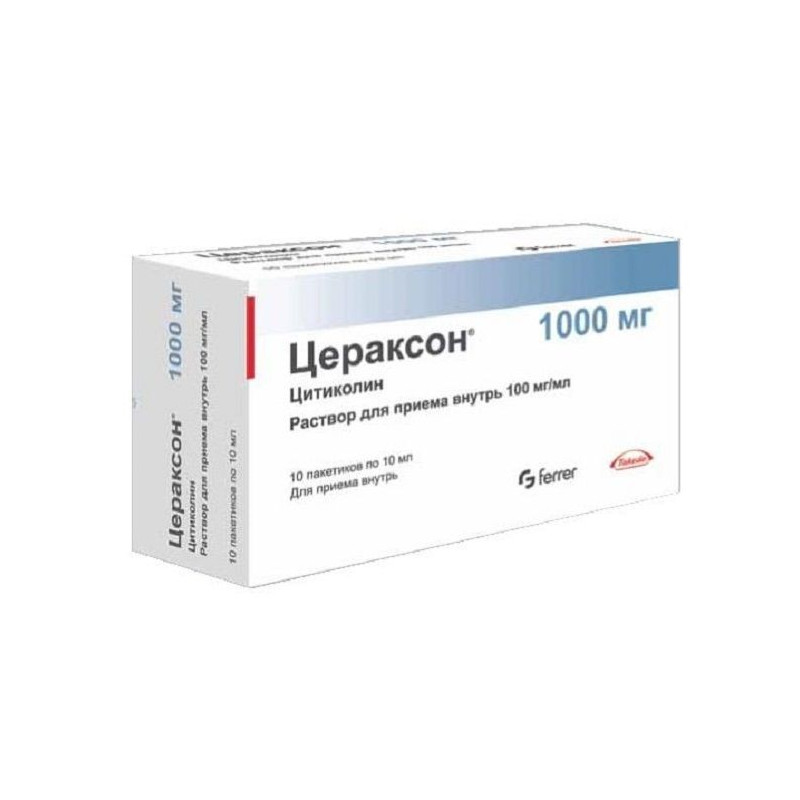



 All payments are encrypted via SSL
All payments are encrypted via SSL
 Full Refund if you haven't received your order
Full Refund if you haven't received your order
- acute period of ischemic stroke (as part of complex therapy);
- recovery period of ischemic and hemorrhagic strokes;
- traumatic brain injury, acute (as part of complex therapy) and the recovery period;
- cognitive and behavioral disorders in degenerative and vascular diseases of the brain.
Oral solution
The drug is taken with meals or between meals. Before use, the drug can be diluted in a small amount of water (120 ml or 1/2 cup).
Acute ischemic stroke and traumatic brain injury: The recommended dose is 1000 mg (10 ml or 1 sachet)) every 12 hours. The duration of treatment is at least 6 weeks.
The recovery period of ischemic and hemorrhagic strokes, the recovery period of traumatic brain injury, cognitive and behavioral disorders in degenerative and vascular diseases of the brain: The recommended dose is 500-2000 mg / day (5-10 ml 1-2 times / day or 1 sachet (1000 mg) 1-2 times / day). The dose and duration of treatment depend on the severity of the symptoms of the disease.
Elderly patients dose adjustment of the drug Cerakson® not required.
Rules for using the dosing syringe
1. Place the dosing syringe into the vial (the syringe piston is fully lowered).
2Gently pull on the plunger of the dosing syringe until the level of the solution is equal to the corresponding mark on the syringe.
3. Before taking the right amount of solution can be diluted in 1/2 cup of water (120 ml).
After each use, it is recommended that the dosing syringe be rinsed with water.
Rules of use of the drug in bags
1. While holding the bag vertically, carefully peel off the edge of the “Open here” mark.
2. The contents of the sachet can be drunk immediately after opening or can be diluted before drinking in 1/2 cup of water (120 ml).
Solution for in / in and in / m introduction
In / in the drug is administered in the form of a slow injection (within 3-5 minutes, depending on the prescribed dose) or drip infusion (40-60 drops / min). In / in the route of administration is preferable to the / m. When i / m injection should be repeated administration of the drug in the same place.
Acute ischemic stroke and traumatic brain injury: The recommended dose is 1000 mg every 12 hours from the first day after diagnosis; treatment duration is at least 6 weeks. 3-5 days after the start of treatment (if the function of swallowing is not impaired), it is possible to switch to oral forms of the drug Ceraxon ®.
The recovery period of ischemic and hemorrhagic strokes, the recovery period in traumatic brain injury, cognitive and behavioral disorders in degenerative and vascular diseases of the brain: The recommended dose is 500-2000 mg / day (5-10 ml 1-2 times / day). The dose and duration of treatment depend on the severity of the symptoms of the disease.
Elderly patients dose adjustment of the drug Cerakson® with in / in or in / m the introduction is not required.
Solution for in / in and in / m the introduction of the ampoule is designed for single use. After opening the vial, the solution should be used immediately. The drug is compatible with all types of isotonic solutions and solutions of dextrose.
Very rarely (<1/10 000) (including individual cases): allergic reactions (rash, pruritus, anaphylactic shock), headache, dizziness, feeling hot, tremor, nausea, vomiting, diarrhea, hallucinations, swelling, shortness of breath, insomnia, agitation, loss of appetite, numbness in paralyzed limbs, changes in liver enzymes. In some cases Cerakson® may stimulate the parasympathetic system, as well as cause a short-term change in blood pressure.
If any of the side effects indicated in the instructions are aggravated, or any other side effects that are not indicated in the instructions have been noticed, you should inform your doctor.
- severe vagotonia (predominance of the parasympathetic part of the autonomic nervous system);
- children's and teenage age up to 18 years (due to the lack of sufficient clinical data);
- Rare hereditary diseases associated with fructose intolerance (for oral solution);
- hypersensitivity to the drug.
Use during pregnancy and lactation
Clinical data on the use of citicoline during pregnancy is not enough. Although no negative effects have been identified in experimental animal studies, during pregnancy, the drug is prescribed only when the expected benefit of therapy for the mother outweighs the potential risk to the fetus.
If necessary, use of the drug during lactation should decide on the termination of breastfeeding, since data on the allocation of citicoline in breast milk are not available.
Contraindicated in children and adolescents under 18 years of age.
Use in elderly patients
Elderly patients dose adjustment of the drug Cerakson® not required.
In the solution for oral administration in the cold, a small amount of crystals may form due to the temporary partial crystallization of the preservative. Upon further storage under recommended conditions, the crystals dissolve within a few months. The presence of crystals does not affect the quality of the drug.
Influence on ability to drive motor transport and control mechanisms
During treatment, patients should be careful when performing potentially hazardous activities that require special attention and speed of psychomotor reactions (including driving and other vehicles, working with moving machinery, the work of the dispatcher and operator).
Due to the low toxicity of the drug overdose cases are not described.
Citicoline enhances the effects of levodopa.
Do not prescribe cerakson® concurrently with drugs containing meclofenoxate.
Terms and conditions of storage
The drug should be stored out of the reach of children at a temperature not higher than 30 ° C.
